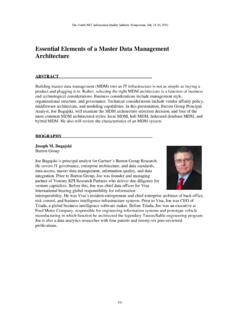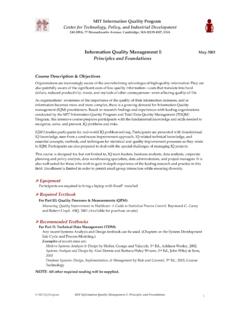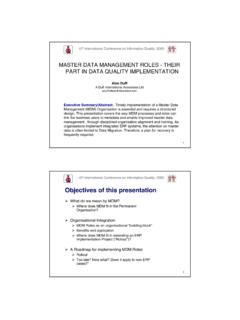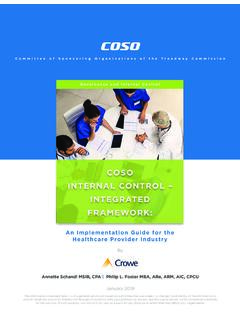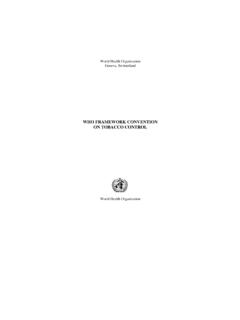Transcription of Designing a Data Governance Framework to Enable and ...
1 Designing a data Governance Framework to Enable and Influence IQ StrategyElizabeth M. PierceUniversity of Arkansas at Little RockProceedings of the MIT 2007 Information Quality Industry Symposium PG 135 Overview of Corporate and Key Asset Governance (Reproduced from 2003 MIT Sloan School CISR) Board Senior Executive TeamKey Assets Every Asset Requires Governance Mechanisms (committees, planning, policies, programs, budgets, measures, etc.) Human Assets Financial Assets Physical Assets Intellect Assets Relation Assets IT Assets strategy Desirable Behavior OthersDisclosureShareholdersMonitoringDa taDataDataDataDataDataProceedings of the MIT 2007 Information Quality Industry Symposium PG 136 Governance of data Assets For most companies, financial and physical assets are the best governed Information assets are often the worst governed, least understood.
2 And most poorly utilized key asset in most firms because data Is increasingly easy to collect and digitize Has increasing importance in products and services Is very hard to value or price Has a decreasing half-life Has increasing security and privacy risk exposure Is a significant expense in most enterprisesProceedings of the MIT 2007 Information Quality Industry Symposium PG 137 What is data Governance ? data Governance is about specifying the decision rights and accountability Framework to encourage desirable behaviors in the use of data data Governance design lays out the decision-making structures, alignment processes, and communication approaches that enables the strategic objectives for data and its quality to be implemented and to monitor how well these strategic objectives are being achieved Note: Governance is about determining whoinputs and makes the decisions and how.
3 Management is the processof making and implementing the decisionsProceedings of the MIT 2007 Information Quality Industry Symposium PG 138 Governance vs. ManagementGovernanceCorporate Governance (Top Mgmt, BOD, SH)Determine how firm is directed and controlledIT GovernanceProvide Oversight, Design Governance Framework and Arrangements to promote good behaviorsData GovernanceManagement(Master or Enterprise) data ManagementDevelop and Support data per Governing Policies and Standards data Requirements & Modeling data Administration Metadata Management data Quality (Enterprise and Local) Privacy and SecurityProceedings of the MIT 2007 Information Quality Industry Symposium PG 139 Linking IQ strategy with the data Governance FrameworkEnterprise IQ strategy and OrganizationData Governance ArrangementsDecision rights via monarchies, federal, feudal, duopolies, Performance GoalsData Organization (IT, Business) and Desirable Behaviors for DataData Governance Mechanisms(Committees, budgets, etc.)
4 Key data Decisions strategy and Principles Architecture Infrastructure & Technology Applications & Processes InvestmentData Metrics and Accounta- bilitiesProceedings of the MIT 2007 Information Quality Industry Symposium PG 140 Steps in Establishing data Governance to Enable IQ Strategy1. Identify Key Enterprise data Processes 2. Articulate a Governance Structure for these Processes A. Who will be responsible, accountable, consulted and/or informed for decisions regarding these key enterprise data processes?B. How will these decisions be made and monitored?3. Track achievement of data objectives, data process performance, and data process capabilityProceedings of the MIT 2007 Information Quality Industry Symposium PG 141 Step 1- Identify Your Key Enterprise data Processes Business data Requirements Info architecture/ data Models/SoA/SoR data (Quality)
5 Management & Admin Structured data Issues data Synchronization Meta data data Retention/ Archiving/Aging data Security/ID Mgmt data Privacy Application Processes data Origination / Authorization Controls data Input Controls data Processing Controls data Output Controls Boundary Controls Unstructured data Issues Document Repository EmailProceedings of the MIT 2007 Information Quality Industry Symposium PG 142 Where in Your Organization are Your Key data Processes and Players? Business Unit(s)Bus. data StewardsBusiness SMEsBus. Req ts & NeedsIT Monitor & Evaluate Plan and OrganizeAcquire & Implement Deliver & SupportData MgmtOperation Systems Other Key Areas BI / ETL Support Other Key Support AreasData Req ts & ModelingData & SecurityData QualitySource System data Stewards data Czar or Director Business Analyst data AnalystData Administrator, CDI data Administrator Metadata Administrator data Security Manager data Quality ManagerInformation Architect Proceedings of the MIT 2007 Information Quality Industry Symposium PG 143 Step 2 Identify your Governance Arrangements and Mechanisms A.
6 Who has Decision and/or Input Rights for the Decisions that must be made concerning your Key data Processes?B. What will be the data Governance Mechanisms ( How will Decisions be Made and Monitored)? Decision-Making Structures Alignment Processes Communication ApproachesProceedings of the MIT 2007 Information Quality Industry Symposium PG 144 Step 2 Cont.: Forming a data Governance Council Its members come from multiple organizations from both IT and business areas It meets on a regular basis Key lines of business are represented There is a list of sanctioned standards that serve as operating principles for handling exceptions, conflicts, investments, metrics and reporting regarding data and its quality The council communicates to executive management, data stewards, project managers, and other stakeholdersProceedings of the MIT 2007 Information Quality Industry Symposium PG 145 Step 2 Cont.
7 : data Governance Council Objectives To provide common processes and policies for information on behalf of the company To enforce the adoption of data standards on every IT project To guide the management of enterprise data across subject areas To reduce scrap and rework associated with poor, missing, inaccurate, unavailable, or hard to find data , and to measure that reductionProceedings of the MIT 2007 Information Quality Industry Symposium PG 146 Step 2 Cont.: Additional data Governance Council Objectives To be accountable for the ongoing improvement of the quality and value of the corporate data asset To support individual project teams in the access and use of common corporate data To establish a common vocabulary and culture around the deployment of company dataProceedings of the MIT 2007 Information Quality Industry Symposium PG 147 Step 3: Track data Metrics and the Value of data to the Business Business data Measures: These measures define what the business expects from its data processes ( outcomes) and what the business would use to determine if its data needs are being met data Process Measures.
8 These measures gauge the efficiency and effectiveness of the performance ( execution) of the data process Benchmark Measures: These measures assess the data process capability expressed as maturity models, derived from the Software Engineering Institute s Capability Maturity ModelProceedings of the MIT 2007 Information Quality Industry Symposium PG 148 Step 3 Cont.: Devising a Balanced data Quality ScorecardProceedings of the MIT 2007 Information Quality Industry Symposium PG 149 Step 3 Cont.: Benchmarking Process Capability against a Maturity Model 0 Non-existent: Complete lack of any recognizable processes. The enterprise has not even recognized that there is an issue to be addressed 1 Initial: There is evidence that the enterprise has recognized that the issues exist and need to be addressed.
9 There are; however, no standardized processes; instead there are ad hoc approaches that tend to be applied on an individual or case-by-case basis. The overall approach to management is disorganized 2 Repeatable: Procedures have developed to the stage where similar procedures are followed by different people undertaking the same task. There is no formal training or communication of standard procedures, and responsibility is left to the individual. There is a high degree of reliance on the knowledge of individuals and, therefore, errors are likely 3 Defined: Procedures have been standardized and documented, and communicated through training. It is; however, left to the individual to follow these processes, and it is unlikely that deviations will be detected.
10 The procedures themselves are not sophisticated but are the formalization of existing practices 4 Managed: It is possible to monitor and measure compliance with procedures and to take action where processes appear not to be working effectively. Processes are under constant improvement and provide good practice. Automation and tools are used in a limited or fragmented way 5 Optimized: Processes have been refined to a level of best practice, based on the results of continuous improvement and maturity modeling with other enterprises. It is used in an integrated way to automate the workflow, providing tools to improve quality and effectiveness, making the enterprise quick to adaptProceedings of the MIT 2007 Information Quality Industry Symposium PG 150 References COBIT published by the IT Governance Institute.
